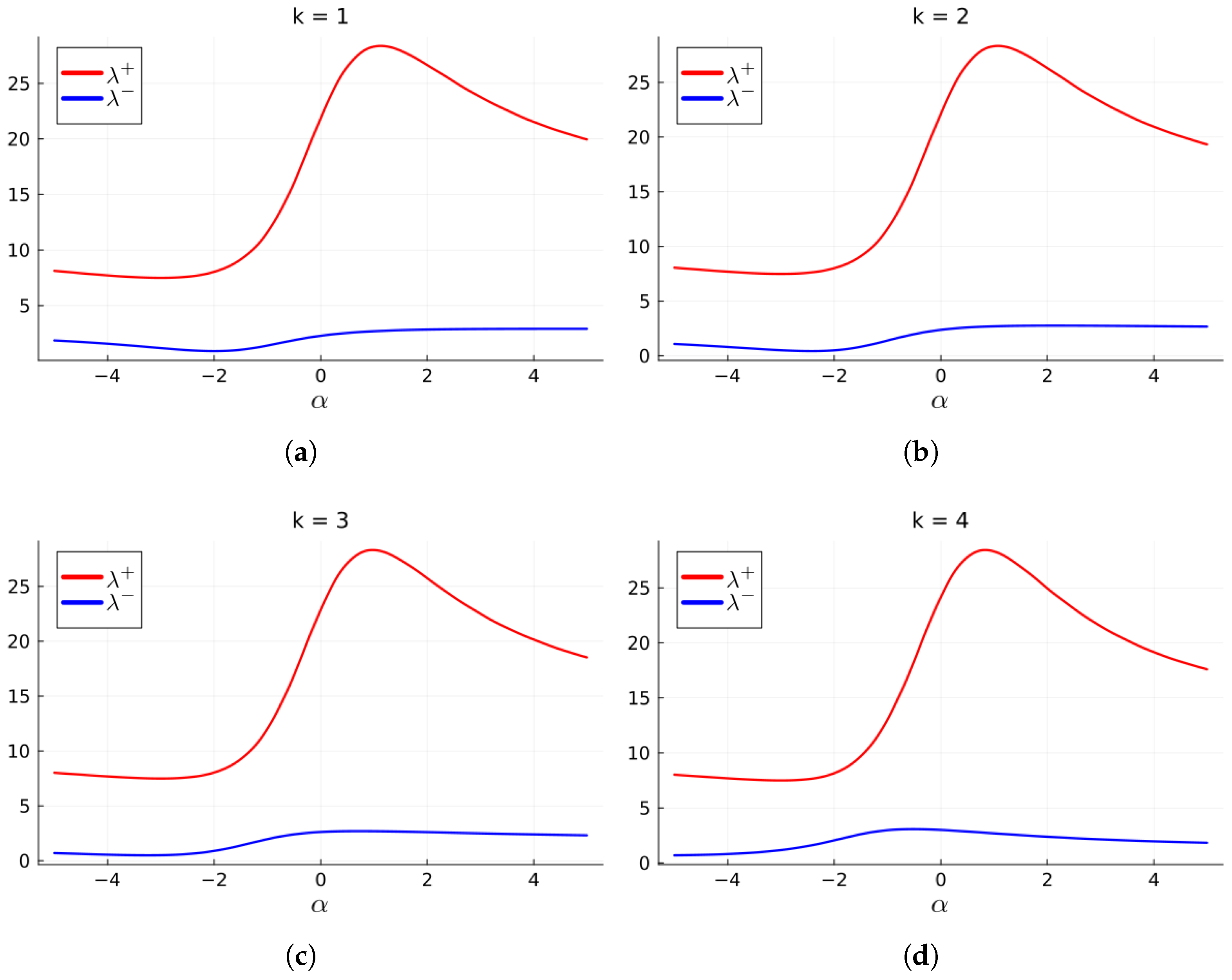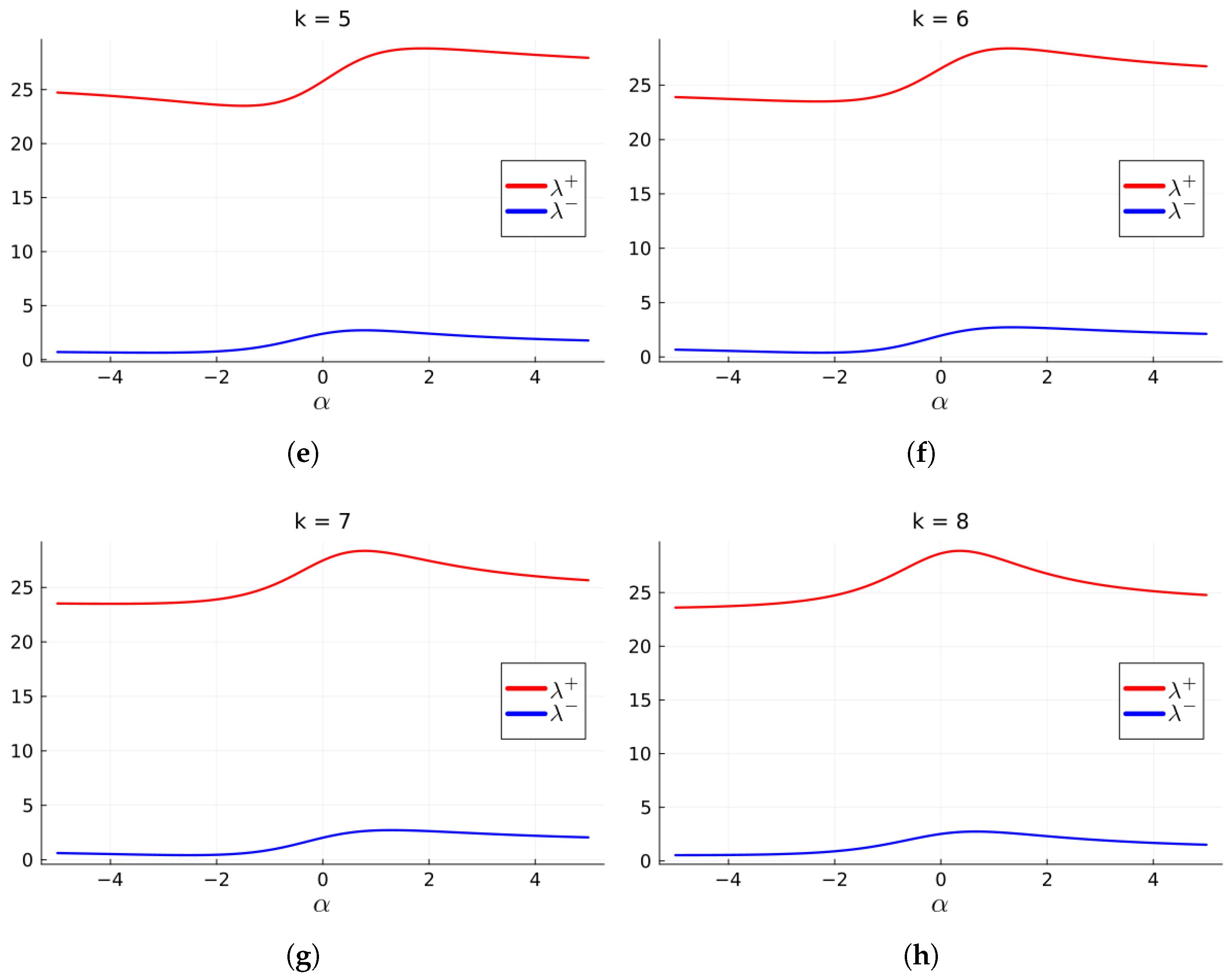1. Introduction
The determination of the spectrum
matrix is a fundamental problem in almost all spheres of science. In fact, if the eigenpairs are known, then this is a complete description of the associated linear operator. In most cases, the solution of the characteristic equation
is unmanageable for large matrix dimensions
n. In this case, numerical methods suffice, for example, the
algorithm [
1]. In some cases, it is only the location of the spectrum that is required, whilst in other instances, knowledge of the extreme eigenvalues is sufficient. Weinstein bounds [
2] and Kato bounds [
3] depend on an approximate eigenpair, which may be evaluated numerically. For real symmetric matrices, Lehmann’s method [
4] provides both upper and lower bounds for the eigenvalues. The Temple quotient [
5] provides a lower bound for the smallest eigenvalue of such a matrix and is a special case of Lehmann’s method. Brauer [
6] provides a method to calculate the outer bounds for
for such matrices. The Rayleigh quotient [
7] is often used when some approximate eigenpair is known to improve the eigenvalue. The Gerschgorin theorem and ovals of Cassini [
8] depend only on knowledge of the entries of a matrix, yet they yield powerful results, especially for large sparse matrices. Trace bounds use only the diagonal elements of a matrix; however, they can yield some very impressive bounds for the eigenvalues. These have been studied extensively by Wolcowicz and Styan [
9]. Sharma et al. [
10] extended and improved the work of Wolcowiz and Styan, whilst Singh et al. [
11,
12] generalized the work of the previous two authors by employing functions of a matrix. Recently, Singh et al. [
13] have introduced a precursor to this article by using all matrix entries. Here we introduce an optimizing parameter which improves the inner bounds. Recently, there has been a resurgence in the effort to efficiently locate eigenvalue bounds for interval matrices [
14] and symmetric tridiagonal matrices [
15].
2. Theory
Let
be a
real symmetric matrix, with eigenvalues
, and denote the associated set of orthonormal eigenvectors by
. We shall assume that the eigenvalues are arranged in the order
Let denote the standard inner product in .
Proof. Let
, where
, then
where
Thus, . The left hand side of (1) is proved in a similar manner. □
Lemma 1. If , where S is a subspace of and n is assumed to be even, then Let , where are orthogonal. An obvious parametric choice for and is the following:
Let
and
, where
are the standard unit vectors in
, with one in the
position and zeros elsewhere. We may thus write
Thus, if
, then
and
It may seem plausible that
and
may be chosen to maximize/minimize
f. However, this is not the case. For constants
and
, we have that
Thus,
, and since the unit ball in
S is independent of the two non-parallel vectors that span
S, it must be true that the extreme values of
f are independent of the choice of
and
of the form given by (2)–(3). It will therefore suffice to use the rather simpler form
where we have chosen the normalized form.
Theorem 2. Let be an orthonormal set in , where n is even; then, the extreme values of , , are given by Proof. Differentiate (8) partially with respect to
and
to obtain
Setting
yields a linear system of equations, which may be cast in the matrix vector form
It is now obvious that the extreme values of f are the eigenvalues of the coefficient matrix in (9). The solution of the characteristic polynomial then yields (6). □
We partition the matrix
into
blocks as follows:
If
and
are chosen as in (4) and (5), we have
where
is the sum of the elements of
. Similarly, we can show that
where
is the sum of the elements of
and
is the sum of the elements of
. Substituting (10)–(12) into (6), we have
We now let the
component of
be replaced by a parameter
,
and
where
and
. For convenience, we shall write (6) as
where
,
, and
.
may be simplified as follows:
where
is the sum of the elements of the
row of
. Similarly, we can show the following results:
where
is the sum of the elements of the
row of
. Since
and
are functions of
, we may differentiate them with respect to alpha to show the following results:
Equation (18) is simplified to yield
In a similar manner, we may show that
Equation (20) may be simplified to the form
From (15) and (16), we have
To find the extreme values of
, (14) is differentiated with respect to
to yield the equation
Equation (23) simplifies to
Equation (24) is now multiplied by
and terms are grouped to yield
The terms in the brackets in Equation (25) can be simplified by using Equations (17), (19), (21), (22) and (25), written in the form
where
Linearizing
about
by using
and finding a zero which we shall call
yields
where
and
; thus,
is now a component in the vector
. From (6), we have
where
Note that
. Let
Thus,
is the sum of the
row of
. Similarly,
Thus,
is the sum of the
column of
. We may thus replace
by
,
by
,
by
,
by
,
by
,
by
, and
by
in our derivations. Thus, from (27)–(29), we have
The solution of
in (26) and
in (31) is easily effected by using a Newton method with starting values
and
given in (30) and (32). This yields single values for the parameter
that is used to optimize both
and
simultaneously using (14). However, this may result in the maximization of
and/or the minimization of
, clearly a situation that we do not desire. However, this routine is simple to implement and automatic. An alternative yet more accurate approach is to minimize
separately and maximize
separately by setting
In this case, an initial value of
chosen arbitrarily can lead to divergence of the Newton routine. It may also lead to the maximization of
or minimization of
. Recall that
is what complicates the issue. A workaround is to sketch the corresponding curves
and
to determine the appropriate initial guesses. This is unfortunately not readily automated. However, the preceding process yields superior results, as we will illustrate. In order to deal with the case of
n odd, we shall use a principal submatrix
of
by deleting the
row and column of
, where
. It is well known that
from the Cauchy interlacing theorem [
16]. In this case, we will be evaluating inner bounds for the submatrix, which are still bounds for the original matrix. The efficiency of this procedure is however restricted by the spectral distribution of
. Another possibility is to pad the original matrix to even order by adding a
row and
column,
so that the extreme eigenvalues of
are unaffected. Here
means to prepend the row and column,
means insert the row and column immediately after row one and column one of
, while
means append the row and column to
. The example for
is illustrated below:
Here refers to the trace of . The well known inequality ensures that the original extreme eigenvalues are not affected. Instead of the trace, one could use as .
Example 1. Here we consider the matrix [
17]
given by The solution for
and
using (26) and (31) is shown in
Table 1. From this, we can accept 2.328878 as an upper bound for
and 28.807700 as a lower bound for
. These are acceptable given the relative ease of computation. In order to obtain a superior lower bound, we solve (33) for optimal
and substitute into (14). These results are summarized in
Table 2. Similarly, to obtain a superior upper bound, we solve (34) for optimal
and substitute into (14). The corresponding results are summarized in
Table 3. From these, we obtain the lower bound 0.394002 and the upper bound 28.882906 However, the latter process requires a good enough starting value for
in the corresponding Newton routine, failing which there is divergence, a value of
that maximizes the lower bound, a value of
that minimizes the upper bound, or convergence to a complex zero. These starting values are obtained graphically for different values of
k, as depicted in
Figure 1. We shall thus not generate these results for further examples.
Example 2. Here we consider the pentadiagonal matrix of odd order [
17]
given by For Example 2, we merely omit the last row and last column of the matrix to obtain and even-order submatrix. However, omission of the
row and column will achieve a similar purpose, though with different results. From
Table 4, we accept 0.089968 as an upper bound for
and 5.260788 as a lower bound for
. We additionally summarize in
Table 5 the best bounds obtained by deleting each of the other rows and corresponding columns. From
Table 5, the best choices for extreme inner bounds are obviously −0.066734 and 5.262994 In
Table 6, we summarize the effect of padding the matrix to even order. Several results are similar, since the padding position does not affect the spectrum of all such padded matrices. This is because each padded matrix is similar to the other by a permutation similarity transformation. From this table, −0.107061 and 5.095542 are acceptable bounds.
Example 3. Here we consider the dense matrix of order 9 given by , where , , and is a chosen diagonal matrix. Since is an involution, . The results using deletion are presented in Table 7. From this the best bounds are −5.823999 and 12.713623 Results using padding are presented in Table 8. Here the accepted bounds are 1.980210 and 12.506700 A similar pattern of results are obtained as for padding in Example 2. If padding is to be used, then it is only necessary to prepend or append the padding to the matrix. Example 4. Here we consider the Hilbert matrix of order 10 given by This is a highly ill-conditioned matrix with and .
The results are depicted in
Table 9. The minimum upper bound for
is accepted as 0.098587, while the maximum lower bound for
is given by 1.563673.









